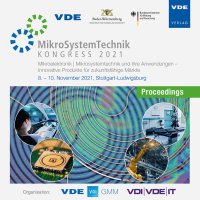Efficient and cost-effective manufacturing of nanostructures with high aspect ratios using Soft UV-Nanoimprint Lithography with bi- and trilayer resist systems
Conference: MikroSystemTechnik Kongress 2021 - Kongress
11/08/2021 - 11/10/2021 at Stuttgart-Ludwigsburg, Deutschland
Proceedings: MikroSystemTechnik Kongress 2021
Pages: 4Language: englishTyp: PDF
Authors:
Handte, Thomas; Scheller, Nicolas (Fachgebiet Technische Optik, Technische Universität Ilmenau, Ilmenau, Germany & 5microns GmbH, Ilmenau, Germany)
Dittrich, Lars (5microns GmbH, Ilmenau, Germany)
Thesen, Manue W.; Messerschmidt, Martin (micro resist technology GmbH, Berlin, Germany)
Sinzinger, Stefan (Fachgebiet Technische Optik, Technische Universität Ilmenau, Ilmenau, Germany)
Abstract:
This article reports the implementation of a bilayer and trilayer resist system, respectively, for the production of nanostructures with high aspect ratios of 14:1 on 4-inch full wafer scale. The bilayer stack consists of a bottom resist layer (lift off polymer LOR1A) and an UV-curable top resist layer (UV-NIL resist mr-NIL210 200 nm). The top resist is structured by UV-nanoimprint lithography with a soft polydimethysiloxane (PDMS) stamp (Soft UV-NIL). After the removal of the residual layer a wet chemical development is performed to achieve an isotropic undercut beneath the nanostructures in the top layer. The creation of an undercut is mandatory in order to perform a successful lift-off. Subsequently a thin aluminum layer is deposited onto the structured resist stack by electron beam evaporation. After lift-off, a nanostructured metal mask remains on the substrate providing a high selectivity during the following plasma etch step. A cryogenic etch process enables high aspect ratio nanostructures within the substrate. An aspect ratio of 14:1 was achieved. The bilayer system is applicable on both silicon and fused silica. For a higher variety and combination of different resists, a trilayer resist system was investigated. An intermediate layer made of silicon oxide is added between top resist (mr- NIL213FC 200 nm) and bottom resist (UL1). The intermediate layer serves as a hard mask in order to etch the bottom resist isotropically utilizing a plasma etching process, thus replacing the wet chemical development step.


